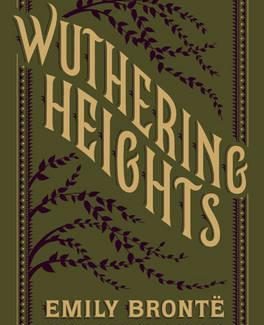Book review: Wuthering Heights by Emily Bronte

January 19, 2021
Wuthering Heights is the perfect mixture of Gothic and Romanticist literature, incorporating elements of reverence for nature, vengeful characters, irrationality, and dark themes that make for a captivating and classic story that is still enjoyable nearly 200 years later. The novel gives some of the best characters I have come across, and the complex relationships they share along with their intense interactions will leave a lasting impact that I don’t think another story could top.
The defining element in this novel is the complicated family tree, a common thing for Gothic literature. But another interesting aspect is how the story is told; Lockwood is the main narrator, who relays the story to readers through the housekeeper Nelly’s telling of it, who sometimes is narrating another character’s experience. It is a story within a story within a story. With complex characters that have even more complex relationships, a jumbled family lineage, and a frame narration, the book makes for a very interesting, though possibly confusing, read.
The story is that of a complicated love relationship that breeds vengeance, with stark contrasts between those that are “civilized” and those that are not. Heathcliff and Catherine are the main characters, though Catherine dies at the end of the first part and is essentially replaced by her daughter, also named Catherine. The eldest Catherine and Heathcliff were clearly in love, and had been since they were children, but Catherine stayed with a wealthy family and got a taste of what luxury and status is like, and she had abandoned the wild childhood she had spent with Heathcliff. She married the son of this wealthy family, even though she even explicitly said that her love for him is like “foliage in the woods,” whereas her love for Heathcliff is like “the eternal rocks beneath.” She told her housekeeper that she could help Heathcliff, who has been regarded as poor and dirty, rise in society if she married a wealthy man. Catherine has been baited into a life of materialism, and thus her love for Heathcliff is clouded by that, whereas Heathcliff would be with Catherine, rich or poor.
So, Heathcliff becomes an angry man, who only desires revenge. He uses the people around him as pawns in order to make Edgar, Catherine’s husband, suffer. After Catherine died, and her daughter became older, Heathcliff arranged marriages between her and his son, whom he let die when he did not care to treat his illness. He married Edgar’s sister to spite him, he dug up Catherine’s grave, he held the younger Catherine hostage, and he took over Edgar and Catherine’s home once Edgar died, all to quell his fiery spirit.
My favorite part of the story, though, is in the beginning, when Lockwood his narrating his own experiences, instead of recording Catherine’s story that Nelly tells him. He is sleeping at Wuthering Heights, Heathcliff’s residence, because the weather would not allow him to go home. He discovers the eldest Catherine’s old journals, and finds her name etched into the wooden panels. During the night, Catherine’s ghost grabs Lockwood’s arm and tries to get him to let her in. This occurred early in the novel, though it became more apparent that it was a random event as I read on. Every other thing that happens in the story is something that could happen in real life—its realistic. This one isolated plot point that displays supernatural elements makes me wonder if it really happened to Lockwood; the reliability of the narration is already in question with how confusing it is presented, so I would not be surprised if he had made it up for the sake of building suspense.
In conclusion, Wuthering Heights is an excellent classic if you’re looking for something unique, with characters that are so dynamic that they may as well be real people. I would give it a ten out of ten.


